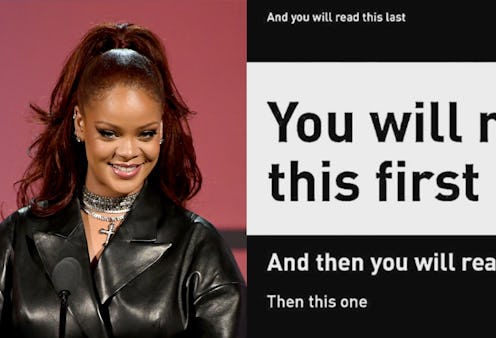Life
A Cognitive Scientist Reveals Why You Can’t Look Away From That Brainteaser Rihanna Posted

Instagram can be the source of a lot of amazing things — beautiful pictures of cute dogs, videos of cute dogs, links to cute dogs you might not yet know — but if you follow Rihanna, your mind might also be blown by this viral brainteaser the Fenty mogul Instagrammed on June 30. The teaser, which accurately predicted the reading patterns of the people who viewed it, raised a lot of questions about reading, fonts, typography and the visual processing mechanisms of the brain.
Fortunately, the secret behind the Rihanna viral reading meme isn't that she's now learned to control our minds. Basically, Rihanna's brain teaser works by pointing out the ways our brains attempt to sort information.
"Our brains are bombarded with 10 millions bits of visual information per second and we cannot possibly process all these information at once," Dr. Farahnaz Wick, a cognitive scientist at Harvard's Visual Attention Lab, tells Bustle. "Our brains select a subset of the available information and try to process only the most useful bits of information in our environment — they are excellent pattern recognizers!"
These patterns, Dr. Wick tells Bustle, explain why we immediately focus on the big letters in the meme first. "We see and read banners, headlines, newsflashes everyday on a webpage, newspaper or banners. So our brains have learnt to pay attention to these patterns in our environment as they are generally important," she says. "This is why the big bold black letters in the meme attract our attention immediately."
This might seem odd considering that text is designed to be read top-to-bottom, but humans take shortcuts in reading all the time. Researchers know that when you read, your brain doesn't individually focus on every word; your eyes tend to skip over words, as your brain uses pattern recognition to predict what's actually there and save time. This is why other brain teasers about accidentally misreading sentences (the ones that often end with "I bet you read that wrong") are so effective.
After we've read the big text, says Dr. Wick, another part of our visual processing comes into play. "Our visual system is tuned to contrast," she tells Bustle, "so even if all the sentences were the same size, the white rectangle against the black background containing the text would immediately capture our attention."
This, she says, is called bottom-up attentional capture. If we see something that's high-contrast in an image, we'll automatically pay attention to it. The smaller text underneath that is read next, because it appears to be the first sentence under a headline — another pattern our brains recognize.
Why do we choose to read the contrasting text before the smallest text at the top of the image? This is pattern recognition once again, says Dr Wick. "Our prior knowledge about how documents are written and organized comes into play," she says. "We do not read the top line first because it is written in the smallest font and aligned to the left. We barely pay attention to the page headers [on documents] because we have learned they are not useful." Think back to the last time you read a book: the very small left-aligned text at the top of the page was likely a page header with repeated information, like the name of the chapter, so you ignored it.
While the meme makes Rihanna seem psychic, it just exposes some natural facts about our attention, the brain's visual processes, and what we prioritize when we read. Watch out for these patterns the next time you see some contrasting text or massive headlines; you might be surprised at how your brain helps you navigate Instagram and the world in general.